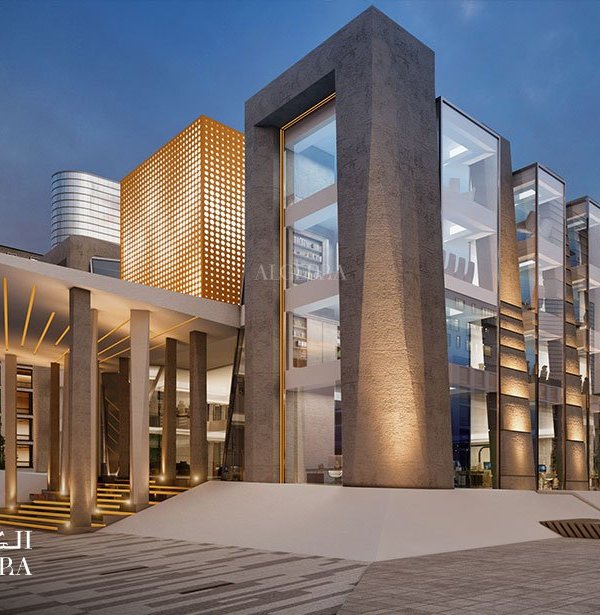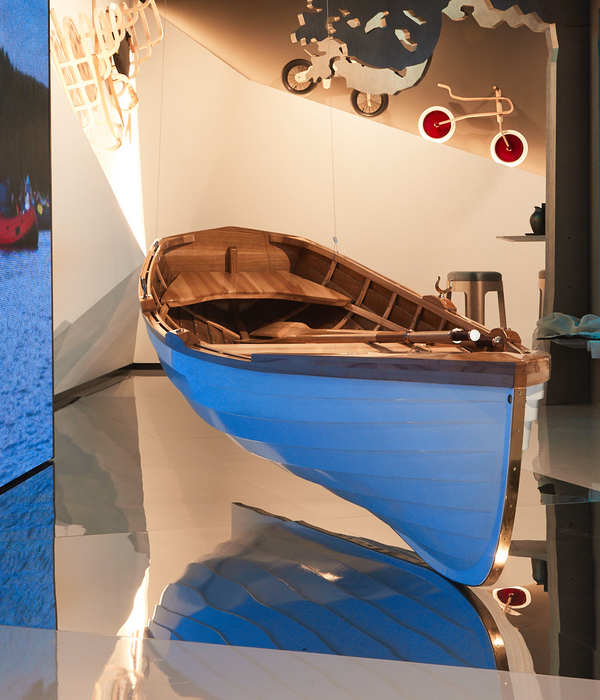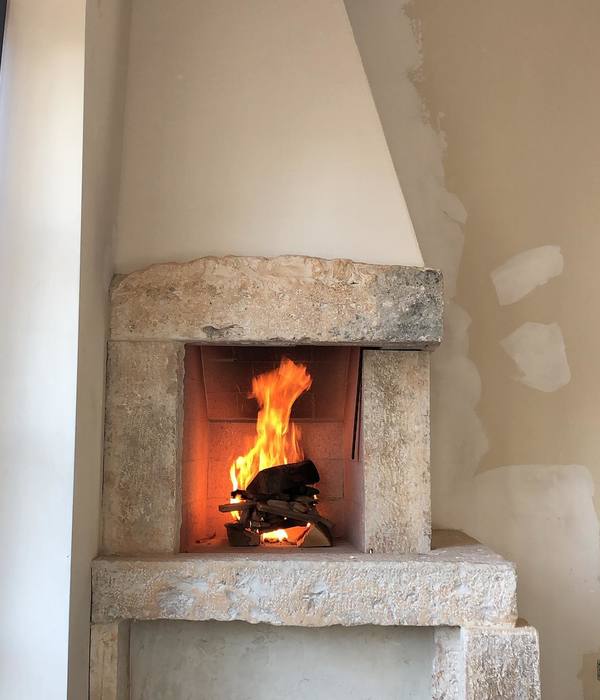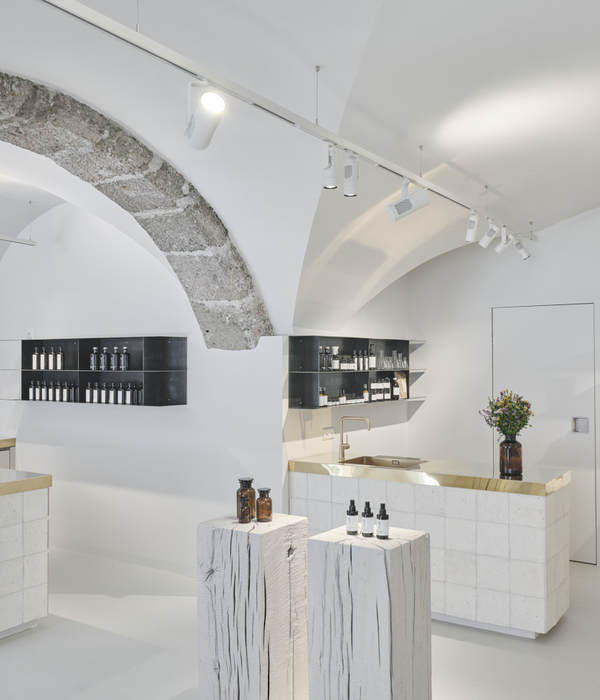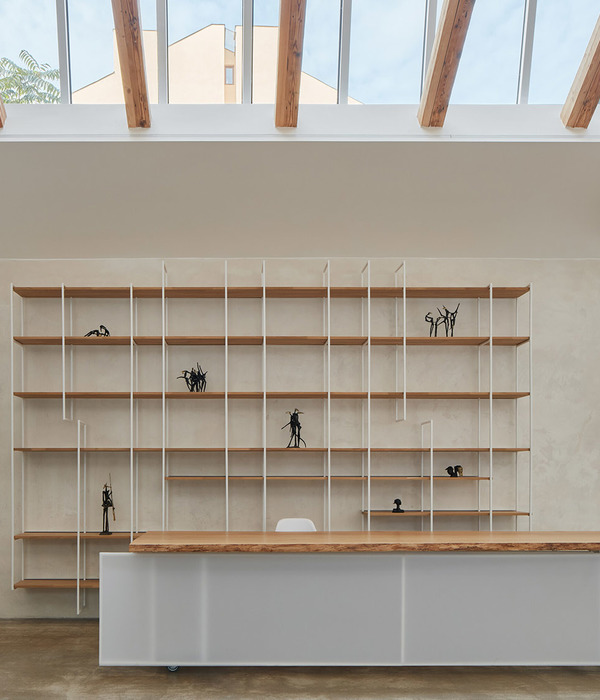密斯·凡·德·罗基金会定期会邀请一些艺术家和建筑师们到展馆中交流新的观点,从而为最具创新性的艺术及建筑作品提供灵感源泉和实验场地。继SANAA、Jeff Wall、艾未未、Enric Miralles、Andrés Jaque和Antoni Muntadas之后,建筑师Anna Bach与Eugeni Bach今年在展馆中完成了他们的项目“密斯失去物质性”(mies missing materiality)。
Fundació Mies van der Rohe periodically invites artists and architects to provoke new perspectives and thought through their interventions in the Pavilion, enhancing it as a space of inspiration and experimentation for the most innovative artistic and architectural production. Following SANAA, Jeff Wall, Ai Wei Wei, Enric Miralles, Andrés Jaque, Antoni Muntadas and others, this year the architects Anna and Eugeni Bach take charge of transforming the Mies van der Rohe Pavilion with their project “mies missing materiality”.
▼项目概貌,overview
▼整座展馆被铺上了完全一样的白色材料,all the surfaces were clad with the same white material
▼细部,detail
该项目旨在将展馆做成一个实体模型:建筑的整个表面被铺上了完全一样的白色材料,使建筑及其改造部分原原本本地展示出来。这座现代建筑史上屹立最久的临时展馆将以1:1模型的形式存在11天的时间。著名建筑师及学者Juhani Pallasmaa将本次建筑介入评价为“一项能够引起大量对话的非凡提案:在联想、记忆、参照性以及相互参照性的层面上都具有丰富的意义。”
The project turns the Pavilion into a mock-up, with all the surfaces clad with the same white material that shows the representative role of both the original work and its reconstruction. For 11 days, the Pavilion will turn into a 1:1 scale model of the longest-standing temporary pavilion in modern architecture. The renowned architect and academic Juhani Pallasmaa defined the intervention as “an extraordinary proposal that will evoke a lot of conversation: an exceptionally rich project in associations, memories, references and cross-references”.
▼这项简单行动使展馆变成了1:1的实体模型,this simple act turns the Pavilion into a 1:1 scale mock-up
▼建筑及其改造过的部分被原原本本地展示出来,the intervention shows the representative role of both the original work and its reconstruction
为展馆穿上新衣,为的是脱去一切物质性
Dressing the Mies van der Rohe Pavilion to strip it of all materiality
这项简单的行动使展馆变成了1:1的实体模型,它通过自我展示带来了多重性的解读,例如原始状态的价值、白色表面在现代意象中的地位,以及物质在空间感知中的重要性。
This simple act turns the Pavilion into a 1:1 scale mock-up, a representation of itself that opens the door to multiple interpretations about aspects like the value of the original, the role of the white surface as an image of modernity and the importance of materiality in the perception of space.
▼白色脱去了建筑的物质性, the white material strips the pavilion of all materiality
巴塞罗那的展馆是一座改造过的建筑,是一次完全忠于原始建筑的复制结果,以至于很难再记起其真实的本质。原本应当是临时性的建筑,后来却成为了不朽的作品,首先是因为它承载了现代运动的历史,其次便是因为其改造本身。将展馆变成模型,使所有表面被铺上同样的材料,成为语义不明的白色,这一做法揭示了建筑的两个具有代表性的身份:最初作为国家的象征而存在,后来则作为前者的复制品而存在。在一段时间内,整座建筑将会成为维持时间最久的现代临时展馆的1:1模型。移除展馆中所有的物质性,也引发了与20世纪建筑历史相关的其他阐释。
The Pavilion in Barcelona upon which we act is a reconstruction, a replica so faithful to the original that it is often difficult to remember its true nature. A building that should have been temporary was immortalised first by the written account of the modern movement and later by its own reconstruction. Turning the Pavilion into a mock-up, with all the surfaces restricted to the same material, as white as it is indeterminate, reveals the building’s representative role—both that of the original, as a national symbol, and that of the replica, by representing the former. For a time, the Pavilion will be the longest-standing 1:1 scale mock-up of the replica of the temporary pavilion in modern architecture. Removing all materiality from the Pavilion also raises other interpretations related to the historiography of 20th-century architecture.
▼“失去物质性”的状态持续了11天,the Pavilion stood as a 1:1 scale mock-up for 11 days
展馆在1932年纽约现代艺术博物馆举办的“现代建筑”展览中荣升为现代建筑的象征。该展览通过一系列照片和文章评论展示了密斯·凡·德·罗、勒·柯布西耶、诺伊特拉、赖特、奥德以及格罗皮乌斯等人的建筑作品,Philip Johnson和Henry-Russell Hitchcock以同样的镜头展示了这些建筑所具有的共性,其中包括现代建筑常见的白色表面:这似乎是最为显著的一个特点。
The Pavilion in Barcelona was enthroned as an icon of modernity at the ‘Modern Architecture’ exhibition at the MoMA in New York in 1932. The exhibition catalogue presents various buildings by architects like Mies van der Rohe, Le Corbusier, Neutra, Wright, Oud, Gropius and others through a selection of photographs and critical essays in which Philip Johnson and Henry-Russell Hitchcock indicate the homogenising criteria for combining all the works through the same lens. These include the white surface as an emblem of a new architecture, which appears as one of the most insistent.
▼水池与雕塑《黎明》,the pool with the famous sculpture
Alba
为展馆赋予均质化的白色,意味着要为之赋予现代历史(并非现代性的历史)中最明显的特征之一。但与此同时,这也将脱去展馆的物质性及其与众不同的特征——尤其是那些使其成为现代运动标志的特征。这一装置使悖论成为了真实的体验。它会帮助参观者通过自身体验去思考这些概念,在完全失去物质性的场馆中构想出其本质的潜力。
To provide the Pavilion in Barcelona with that homogenising whiteness means to endow it with one of the defining features of modern historiography (not of modernity). Yet at the same time, it also involves stripping the Pavilion of its materiality and its unique characteristics—specifically the one that erected it as an icon of the modern movement. The installation turns this paradox into an experience. It helps visitors to consider these ideas and many more through their own experience in a pavilion that will lose all trace of its materiality for a few days to assume all its representative potential”.
▼均质化的白色使参观者通过自身体验进行思考, the homogenising whiteness helps visitors to consider more through their own experience
▼“去物质化”的过程,the process of dematerialisation
▼游学在巴塞罗那 Barcelona
关于文飞
文飞(苏州)建筑师室内设计工作室 创始人 设计总监
环球旅行30+国家、全球50+主要城市,多年的设计行业经验积累与海外游学沉淀,对不同的流派地域文化、不同的风格设计理念、在对生活方式艺术的追求有着融会贯通的独特设计见解。
WDESIGN DESIGN 文飞(苏州)室内设计事务所
{{item.text_origin}}

